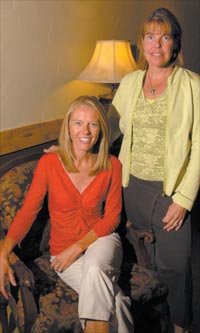 | 
 Lasting Impression Lasting Impression
Sage Advice
By Kimberly Nicoletti
Photo by Mark Fox
Mountain House & Home
Wild Sage Interiors
The National Association of Home Builders
expects about half of the homes built in 2010 to
be “green.” With this in mind, Cassidy Brush and
Katherine Collins, co-owners of Wild Sage Interiors
in Keystone, became Summit County’s fi rst
LEED (Leadership in Energy and Environmental
Design) accredited professionals in commercial
interior design. They plan on pursuing the LEED
accreditation for residential homes as soon as the
United States Green Building Council launches it.
The 100-hour-plus licensure process qualifi es
them to work collaboratively with architects and
builders to design a completely environmentally
friendly home, inside and out.
“We are often the
interface between homeowners and builders, so
we have a lot of opportunity to educate people
as to what’s out there,” Brush says. “It’s growing
quickly; every year, there are more products.”
She says if a homeowner builds “green” but
fails to incorporate “green” interior design or
uses materials that contradict the effort, it can
be completely counter-productive. Brush and
Collins are knowledgeable about low-emitting
carpet materials, Forest Stewardship Council
certifi ed wood, low-fl ush toilets, effi cient use of
natural light, furniture manufacturers that employ
“green” practices and more.
“We take a holistic,
educational, collaborative approach when meeting
with our clients,” Brush says. “This ensures
we’re helping them understand the bigger picture
of their good efforts and intentions.”
As Collins
points out, it is no longer enough to simply pick
out pretty items.
“Being conscientious about
our choices is paramount to the new paradigm
of a sustainable future,” Collins says, pointing
out they can now offer clients new possibilities
that are not only beautiful but also nontoxic.
The two women handpick “green” vendors they
know use environmentally friendly processes,
from start to finish. For example, one aspect
they consider is how much petroleum it takes to
get a specifi c product from point A to B; bamboo
may be a sustainable material, but if it’s grown in
China, there are further environmental impacts
to weigh.
“The process is effortless for our
clients as we take care of all of the execution and
coordination, from ordering elements of décor to
communicating with contractors,” Collins says.
“Once we understand their style, they can sit
back, relax and leave the rest to us.”
Click here to read the article in PDF format.
|  |
